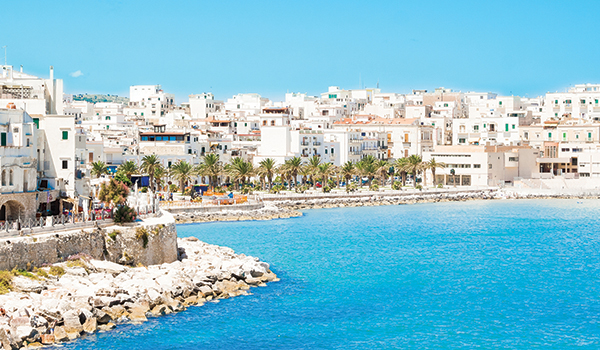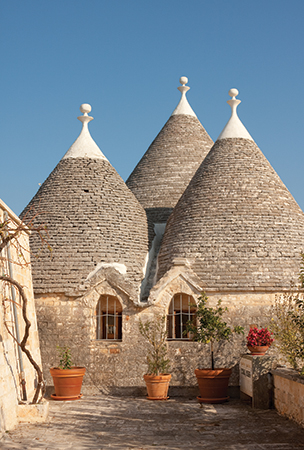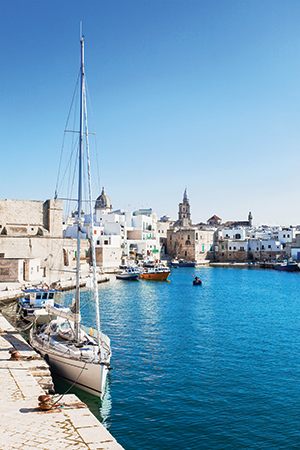Striking, sun-washed Puglia is a very distinctive bit of Italy, with landscapes and building styles like nowhere else. Beautiful, orderly and affordable, this far-southern region rightly continues to enchant foreign buyers, says Fleur Kinson.
Forming the graceful high heel of the Italian boot, Puglia strikes a distinctive shape on the map. And it’s no less distinctive down on the ground, with many unique attributes. Puglia has the longest coastline of any Italian region, for one thing. The Mediterranean laps the region on both sides, and you’re never very far from the blue and turquoise water. All that dazzling sea light lends extra magic to Puglia’s bright landscapes and unusual buildings – chalk-white sands and crop-fields of crimson soil, sugarcube houses and circular cottages topped with conical roofs. In look and feel, Puglia has a touch of the fantastical.

Faintly otherworldly, Puglia is also faintly other-national. It’s the most Greek-feeling part of Italy, which is unsurprising when you consider that Greece is only fifty miles or so across the sea, and that there’s a very long history of contact between Puglia and its Hellenic neighbour. Exotically, Greek words can still be heard in the local dialects and there’s something rather Greek in the manner of the people, too. Puglians are hugely hospitable, and they’re a little more reserved than the usual flamboyant southern Italian stereotype. That said, all the best of southern Italian life is on offer here – the stunning food, colourful festivals, vibrant evening passeggiata and warm welcomes we non-Italians so love.
Puglia is a quietly prosperous and well-run sort of region. It’s said to have the lowest levels of corruption in southern Italy, and the lowest rates of unemployment. The cities are small, and the crime-rate rock-bottom. Even the ground underfoot is well-behaved, with southern Puglia having the lowest earthquake risk of anywhere on the entire Italian peninsula. Summers are long and hot, annual rainfall is very low (the very name ‘Apulia’ refers to this fact), and the pace of life is healthy and relaxed. All in all, there are many reasons to want to find yourself down here.
Looking to buy
Northern Italians have been wise to the delights of Puglia for decades, with many travelling here to enjoy summer sun and sea, but the region only came to foreign buyer attention in the early 2000s, when budget airlines gave northern Europe direct connections. Exploratory Brits were the first to begin snapping up the fabulously low-priced homes available in Puglia, with the gorgeous Itria Valley area between Bari and Brindisi their chief target – not least because of its wealth of unique trulli cottages with their fairytale conical roofs.

This flood of interest saw local property prices rise, but not explosively (ruinous booms and busts are not the Italian way), and Puglia remained attractively inexpensive. Foreign buyers had just begun opening up other parts of Puglia – notably its far south – when the international financial crisis came along and put fright into many of them. In Puglia, as across the rest of Italy, foreign buyer numbers languished over subsequent years and property prices eventually drifted downwards a little.
Today, Puglia’s market seems to be slowly recovering. Visitor interest in the region never dimmed, and now that the shock of 2008 onwards seems to be fading, some of those visitors are coming back with a view to buying a home in what is still a wonderfully unspoilt bit of Italy offering excellent value for money. We’ll look more closely in a moment at which parts of Puglia might be best for your taste and budget, but for the moment here’s a very rough guide to what you might generally expect to pay for homes across Puglia these days.
At the very lowest end of the scale, you might find a small country home needing extensive restoration for as little as €30,000, or a modern-built two-bedroom house for €80,000. Seaside apartments start at about €100,000 as do old rural houses with land. For €250,000 you might get a seaside villa, a three-bedroom home with a pool near a fashionable old town, or a nice old country house. Puglia’s distinctive farmhouse-mansions, called masserie, start at about €400,000, and can rise into the millions.
Head over heels
Naturally, some parts of Puglia are more appealing – and more expensive – than others. It’s useful to get a general grasp of where you might want to be before you begin your property hunting, so we’re going to talk physical geography and market dynamics at the same time. A first point to note is that, like all Italian regions with a coastline, property prices in Puglia tend to be higher the nearer to the water you are. However, as half of this long, slender region has coast on two sides, even a low-priced inland home puts you within easy reach of the sea.
“Only half of the region?” I hear you ask. The northwestern half of Puglia has sea on one side only, and perhaps for this and other reasons this has so far been the least popular section of Puglia with foreign buyers – especially the further northwest you go. The area around Foggia has a relatively flat landscape which many find uninteresting, although the nearby ‘ankle-spur’ of the Gargano Promontory is an exceptionally beautiful stretch of highlands and dramatic coast all protected as National Parkland, and some buyers have been drawn here.
The lower half of Puglia, the actual high heel itself, is called the Salento peninsula and it’s this half that has most seduced foreign buyers. Who wouldn’t fall for an area where beaches of coarse pale sand alternate with steep white cliffs plunging into brilliant water, and where inland hills are fuzzed with gigantic olive groves or topped with entrancing old towns? The peninsula is divided into ‘Upper Salento’ and ‘Lower Salento’. Upper Salento, handily book-ended by airport-towns Bari and Brindisi, is where the foreign buyer market first took off in Puglia. You’ll find the charming Itria Valley area here, with its lovely countryside, cute trullo cottages and unforgettable old towns such as Ostuni, Locorotondo and, of course, Alberobello.
Unsurprisingly, Upper Salento is generally the priciest area of Puglia, although it’s still possible to find plenty of great value for money properties here. Johan Zetterberg of the agency Casa Puglia advises that the costliest locations in Puglia are currently Monopoli and Rosa Marina – two delightful seaside resorts situated midway between Bari and Brindisi – and Selva di Fasano, which sits a few miles inland from these two. But, he adds, “The best value for money we find is in the San Vito dei Normanni area (between Brindisi and Ostuni), where you can buy a two-bedroom cottage with two acres of land and do it up for a total of €150,000.”

And Lower Salento? As suggested earlier, the foreign-buyer market in this part of Puglia was beginning to blossom when the international financial crisis hit in 2008 and put things in a state of suspension. Landscape-wise, Lower Salento is a slightly dryer and rockier sort of place than Upper Salento, but the coast is glorious and many of the little towns are fascinating. This, coupled with very low property prices, makes this definitely an area worth considering. Johan Zetterberg of Casa Puglia says it’s possible to get a detached house for as little as €40,000 down in Lower Salento.
Building in style
Anyone thinking of buying in Puglia should have at least a passing familiarity with some of the region’s interesting indigenous building styles. As we noted at the outset of this article, Puglia has some fairly unique domestic architecture, and this contributes to the special look of the region.
The aforementioned trulli are tall conical roofs, which may sprout singularly from a little round cottage, or rise in twos or threes from larger dwellings. A lamia, meanwhile, is a type of simple cubic country house, invariably whitewashed so that it looks from a distance rather like a giant sugarcube. Then there is the masseria, a very stately sort of mansion-farmhouse that usually sits surrounded by fertile land and often forms part of an estate of rural buildings. Some of Puglia’s grander masserie have been turned into luxurious spa hotels and the like, but plenty of others have been snapped up by foreign buyers.
Interesting buildings, combined with relatively flexible planning regulations and superlative local builders and crafts people, have made Puglia a very popular place for buyers hoping to restore an old property. Some very creative and beautiful projects have taken shape down here, and in many cases their total spend has been much lower than what a property bought ready-restored would have cost.
Buyers harbouring a dream to bring an old property back to life and turn it into a bespoke house should certainly consider Puglia. Sure, projects won’t bound ahead at lightning speed – remember that the slower pace of life is probably one of the things that appeals to you about southern Italy – but the standard of work and the dedication of the builders you employ are likely to more than compensate.
And rentals?
Finally, no feature on Puglian property should fail to mention the excellent holiday rental prospects the region affords. As suggested earlier, visitor numbers to Puglia have only ever increased since the region first appeared on the European budget airlines map back in 2004. Neither the financial crisis nor subsequent austerity has significantly deterred tourists from coming here. Note that most visitors are the discerning, independent-traveller kind. There is no mass tourism infrastructure in Puglia. This remains an authentic and unspoilt place.
Blessed with long summers, Puglia’s rentals season lasts from around May to October. Visitors come for the delights of the seaside, but also all the charm of historic towns stuffed with handsome buildings and superb restaurants. So there are many areas in which a home could attract a good rental clientele. Key areas include the coast, any attractive stretches of countryside (with the Itria Valley area probably at the top of the list), and any of the towns most appealing to tourists – such as Ostuni, Alberobello, Lecce, Otranto, Taranto, Polignano a Mare, Monopoli, Rosa Marina and so on.
